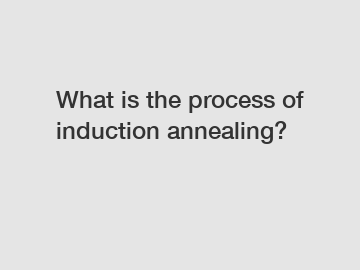What is the process of induction annealing?
What is the process of induction annealing?
Induction annealing is a heat treatment process that is commonly used in industries to modify the properties of metal parts and components, through controlled heating and cooling cycles. This process involves the use of electromagnetic induction to generate heat within the material, enabling uniform and precise heating without direct contact. Induction annealing has proven to be a versatile and effective technique in various applications, ranging from small-scale operations to large-scale industrial production. But how exactly does induction annealing work? Let's delve into the process and explore its key aspects.
1. Electromagnetic induction:

The foundation of induction annealing lies in electromagnetic induction, a phenomenon discovered by Michael Faraday. When alternating current (AC) passes through a coil, an alternating magnetic field is generated. This magnetic field induces eddy currents within the conductive material, resulting in resistive heating. In the context of induction annealing, a highly conductive coil, known as an induction coil, is placed around the metal part to be annealed. As the alternating current flows through the coil, the metal part heats up due to the induced eddy currents.
2. Heating and Time:
During the induction annealing process, the metal part is rapidly heated to a specific temperature and held at that temperature for a predetermined duration. The duration and temperature are critical factors that depend on the material being annealed. Different alloys and metals have distinct annealing requirements to achieve desired properties, such as improved ductility, reduced hardness, or stress relief. The heating and cooling rates are carefully controlled to prevent thermal shock and ensure uniform annealing throughout the material.
3. Cooling and Quenching:
After the desired temperature is reached and maintained for the required time, the metal part is subjected to controlled cooling or quenching, depending on the desired outcome. Quenching involves rapidly cooling the material by immersing it in a liquid or using forced air, which can result in increased hardness and strength. On the other hand, controlled cooling allows for slow and controlled reduction in temperature, which can enhance ductibility and relieve stress in the material.
4. Benefits of Induction Annealing:
Induction annealing offers several advantages over other methods of heat treatment. Firstly, the process can be easily automated, allowing for efficient and consistent production. Additionally, induction offers precise and localized heating, reducing the risk of warping or distortion. Furthermore, the high heating rates of induction annealing facilitate shorter cycle times, making it a cost-effective choice for large-scale production. Moreover, induction allows for easy scale-up, accommodating parts of various sizes and geometries. This process also boasts energy efficiency, as the heat is generated directly within the material, minimizing heat loss.
In conclusion, induction annealing is a highly effective heat treatment process that harnesses electromagnetic induction to modify the properties of metal parts and components. By understanding the principles underlying induction annealing, including electromagnetic induction, heating and time control, cooling, quenching, and the benefits it offers, industries can utilize this technique to enhance the performance and functionality of their products. Whether it is in the automotive, aerospace, or manufacturing sector, induction annealing plays a vital role in optimizing the structural integrity and mechanical properties of metal materials, driving innovation and efficiency in modern industries.
Are you interested in learning more about Induction Heat Treatment Machine, high power high frequency welders, annealing equipment for steel pipe supplier? Contact us today to secure an expert consultation!

Comments